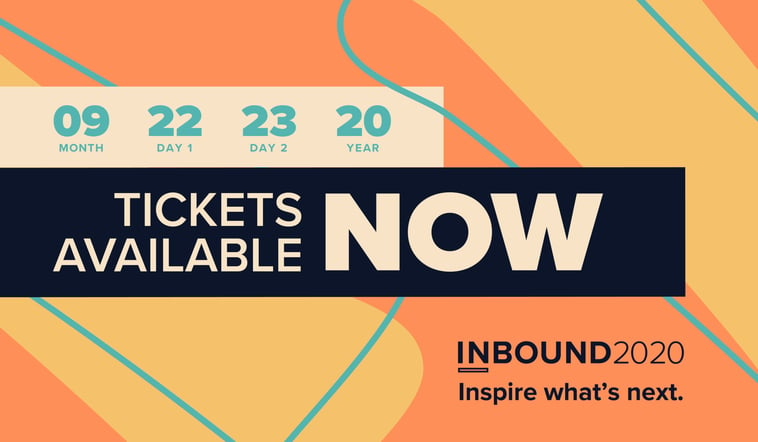
This post is sponsored by INBOUND2020. On September 22nd and 23rd, pick the brains of leaders like Bob Iger (CEO of Disney), Alicia Garza (Principal at Black Futures Lab), Sandy Carter (VP of Amazon Web Services), and Sasan Goodarzi (CEO of Intuit) and learn about how the Sales and Marketing landscapes are changing. INBOUND2020 is an immersive digital event hosted with love by HubSpot. Be sure to grab your Powerhouse Pass now!
When you call a prospective client and ask them for a meeting, you are asking them to give you their most valuable commodity and resource, their time. Time is something people work to maximize by ensuring it is used to pursue their goals, the projects that lead to those goals, and the initiatives critical to their success. Many of these people would have an easier time giving you money than their time, recognizing that they can get more money, but there is no way to recover time they’ve lost.
The words that you use to ask for a meeting suggest an agenda, but in many cases, not one that your contact finds valuable enough to command their time or their attention. If the plan doesn’t suggest that your contacts are going to benefit from spending time with you, they are right to reject your request.
Here are a few ways you can evaluate your ask and ensure you have an agenda that your contacts can say yes to.
Your Meeting Agenda
Recently, a salesperson reached out to me to ask me if I am available on a certain day. That was the only line in the text message, making it impossible for me to determine what the agenda might be (other than a straight pitch). Because there is no way to discern how the meeting might benefit me, I am forced to say no.
When you ask someone for their time, you are responsible for providing the agenda for the meeting. Without an agenda, you make it easy for your prospective client to say no to the meeting.
How Much Time You Need
When you suggest a meeting, most people believe you are asking them for an hour, mostly because that was the default when you scheduled in Microsoft Outlook, a software that dominated the business market for many decades. By leaving out the amount of time you are asking your contact to give you, you make it more difficult for them to say yes to your request.
If you need an hour and have a compelling agenda that requires that much time, you may need to ask for a full hour. Much of the time, however, you can have an effective meeting some smaller amount of time, like thirty-five minutes. When you are trading value for time, the equation is positive for your contact when you can create massive value in a relatively small amount of time.
In all cases, tell your contact how much time you need, as well as what you are going to do with it.
What’s Their Outcome
Of all of the mistakes one might make when asking a prospect for a meeting, failing to provide a value proposition for the meeting has to be the most prevalent. It is also the reason so many of the people you ask for time reject your request. The reason your contact rejects your request is that there was no value proposition to which they could potentially say yes.
Most salespeople are not self-oriented, even though their approach can make it sound like they might be. When you are asking for a meeting, the outcome of that meeting is to leave with a commitment to further explore change. The best outcome for you is that you create a new opportunity in your CRM. When you use language that suggests you want to talk about your company and your solutions, you are not providing your contact with an outcome that helps them.
The one question you need to answer is, “How is my contact going to be better off from having met with me, even if they don’t buy anything from me right now?” When you can successfully answer this question, you will have an easier time providing an outcome that your contact can agree to.
What Can You Teach Your Contact
A modern B2B sales approach starts with the idea that you are going to need to be consultative, which means helping your clients see and understand something that was opaque and indiscernible before you provided clarity. The obstacle here for most salespeople is that they believe their clients know more than they do, something that is true as it pertains to their knowledge about their business, but false as it pertains to what they know about producing the better outcomes you sell.
The inability to provide your prospective client with a perspective that they lack or some insight that will help them improve their results makes it more difficult for you to gain a meeting and create value for them in trade for their time. It’s important that you are able to explain what you might share that will help your contacts make good decisions around their business and their future.
The more compelling your agenda and the value you will create for your contacts, the easier you make it to agree to the first meeting. The better you can convey that value over the telephone and in the follow-up voice mails and emails you send, the greater your chances of sitting down with your dream client to discuss the things that might result in a new opportunity for you and your prospective client.
Most salespeople fail to acquire meetings from failing to follow “the trading value rule,” which suggests that any time you ask a client to make a commitment to a conversation, you are responsible for explaining to them the value they receive in trade. If you can’t explain how your contact is going to be better off after a meeting, you are not giving them what they need to be able to say yes.

Get the Free eBook!
Learn how to sell without a sales manager. Download my free eBook!
You need to make sales. You need help now. We’ve got you covered. This eBook will help you Seize Your Sales Destiny, with or without a manager.
Download Now







.jpg?width=768&height=994&name=salescall-planner-ebook-v3-1-cover%20(1).jpg)


